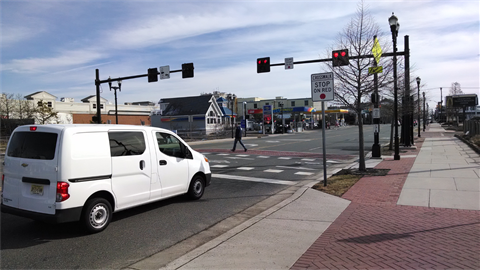Learn more about signals that enhance pedestrian and bicyclist safety
Published on December 06, 2023

Rectangular Rapid Flashing Beacons (RRFB) and High-Intensity Activated crossWalKs (HAWK) are traffic signals that enhance crossing safety for pedestrians and bicyclists. Both are pedestrian-activated devices used in tandem with marked crossings, but they operate differently and have distinct features.
Rectangular Rapid Flashing Beacon (RRFB)
RRFBs are warning signs located at intersections or at mid-block crosswalks and consist of two rectangular lights below a pedestrian crossing sign. Typically, when a pedestrian or bicyclist wishes to cross at an RRFB crossing, they can push a button to activate the set of yellow lights in an alternating, high frequency pattern. This flashing pattern enhances the visibility of pedestrians and the crosswalk itself, while alerting drivers to prepare to yield.
It is important to note that unlike a traffic signal or HAWK signal, RRFBs do not require drivers to stop. Always look both ways and make eye contact with drivers before crossing.
High-Intensity Activated crossWalK (HAWK)
The HAWK beacon signal, also called hybrid beacon, is like an RRFB signal in that it enhances pedestrian and bicyclist crossing safety at intersections or mid- block crosswalks. However, HAWK signals function more akin to a traffic signal, requiring drivers to come to a complete stop to allow pedestrians to cross.
HAWKs are usually comprised of two red lenses over a single yellow lens. Typically, once a pedestrian or bicyclist presses a button, the signal goes through a series of phases to control traffic and provide a safe, protected crossing. The sequence operates as follows:
- Flashing yellow – drivers should be aware that a pedestrian is preparing to cross.
- Steady yellow – drivers should slow and prepare to stop.
- Solid red – drivers must stop and remain stopped, as with a standard traffic signal. A "WALK" signal is also displayed for pedestrians to indicate it is safe to begin crossing.
Once the pedestrian or bicyclist has finished crossing, the signal’s lights may flash red. If there are no other people present, this indicates that traffic can proceed after making a stop at the crosswalk. Otherwise, the signal will turn off and traffic can resume.